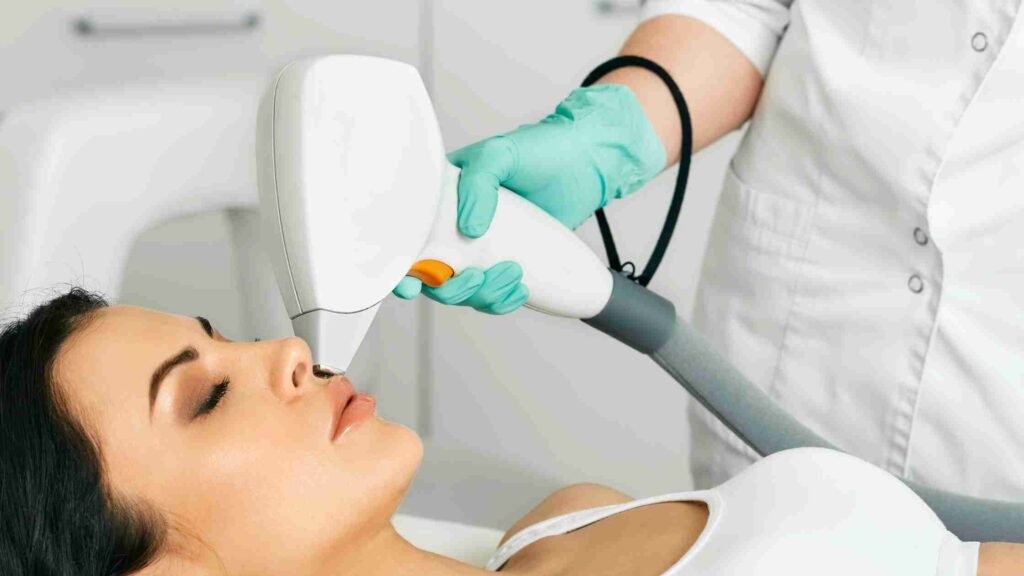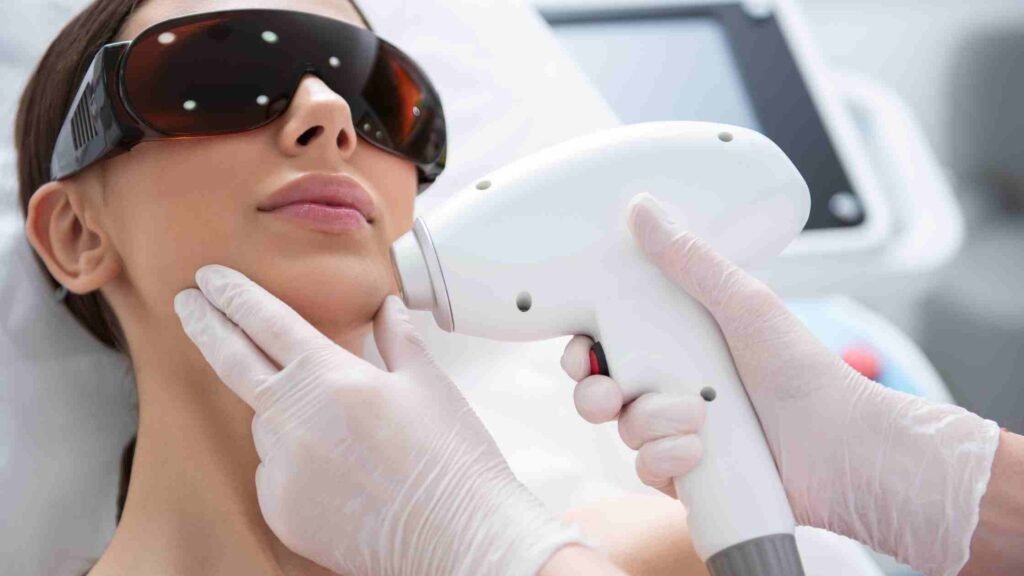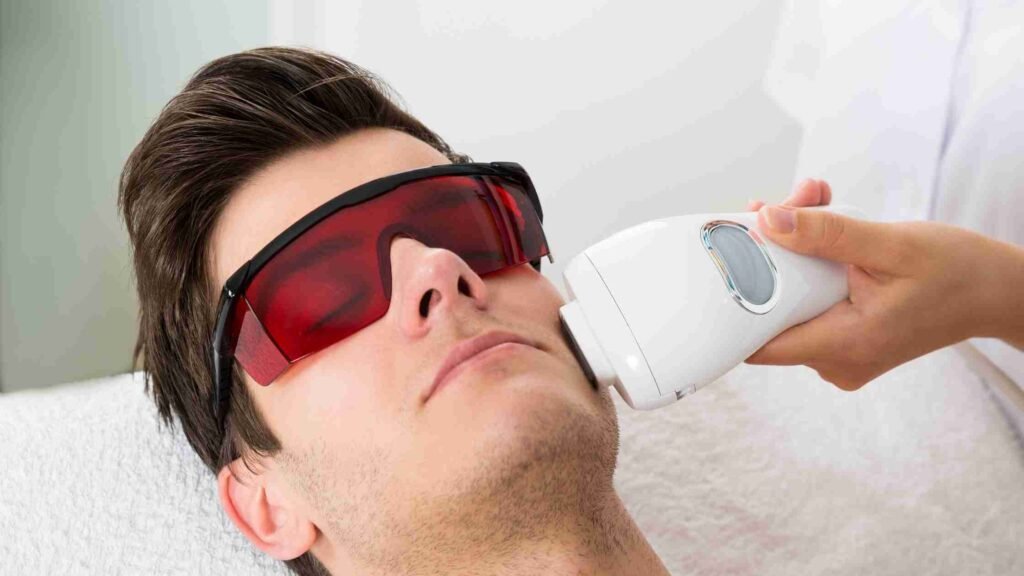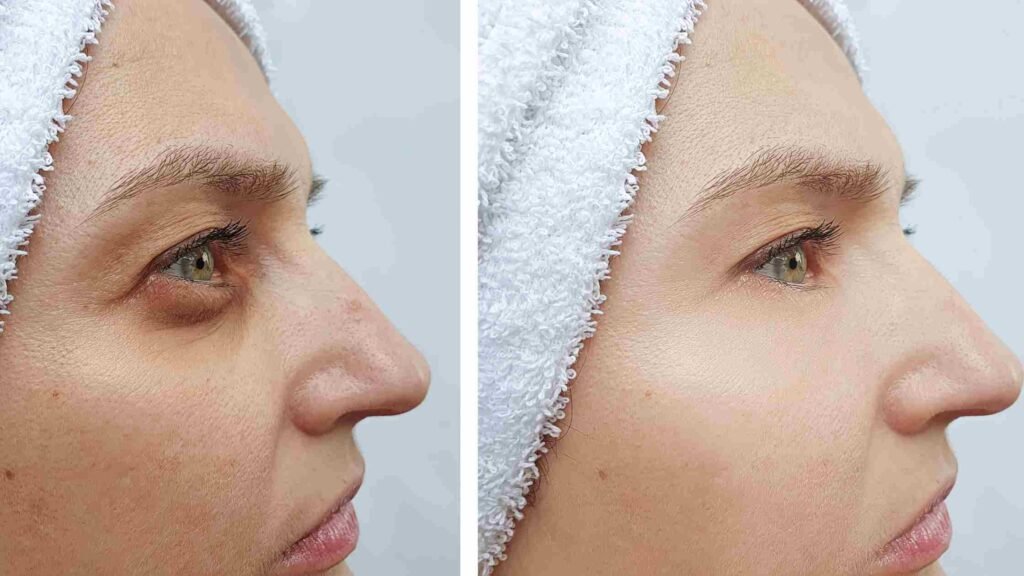Our hair is an integral part of our life. And just like some people have more hair on their heads, some also have more facial hair than others. Though it is common for men to have excess hair growth on their faces, women often don’t have much facial hair. But that is not the case for every woman since some women naturally experience hair growth in the upper lip, chin, chest and back like men. And whether a few random hairs are popping up on the chin, upper lip or another facial region, the presence of facial hair is more than irritating for many.
Some women don’t care much about having more facial hair since their monthly hair removal routine covers extra hair growth, while others look closely at why they get upper lip and chin hair. Before getting into all the tried and tested methods of removing upper lip and chin hair temporarily and permanently, they want to know about the causes of the upper lip and chin hair growth.
Read more about Bikini Laser Hair Removal Cost in Hyderabad
We performed thorough research and chatted with a few dermatologists to write an informative article for you that will help you know the reason behind excess hair growth on your face, how to diminish the appearance of facial hair and how to get rid of them permanently.
Read this article till the end to get answers to every question that you have in your mind regarding upper lip and chin hair growth.

Why Does Upper Lip And Chin Hair Growth Occur?
Discovering abnormal hair growth on your chin and upper lip is pretty normal. Ageing, shifting hormones, and even genetics can be the reason behind your chin and upper lip hairs. And there are a few simple and efficient ways to remove those hairs if you don’t want them.
But suppose you are noticing more than just a few hairs on your upper lips and chin area that are coarser than others, or you have seen a sudden increase in facial hair growth. In that case, you need to pay attention since excess coarse facial hair in women may signify some medical conditions requiring treatments.
All women typically grow a few hairs on their chin and upper lips. It occurs due to the vellus follicles in women’s bodies that produce delicate, tiny, light-coloured hair referred to as peach fuzz. Those hairs help regulate the body temperature. During puberty, the vellus follicles become large in size n making terminal hair darker, longer and coarser. The hormones that play a pivotal role in the enlargement of vellus follicles are androgens, usually present in men at a high level.
And when the androgens present in women’s bodies shift their level periodically because of weight gain, ageing and other factors such as menopause and pregnancy, it can result in more terminal hairs in unexpected places like the chin and upper lip.
Read more about Underarm Laser Hair Removal Cost in Hyderabad
There are also times when the chin and upper lip hair is a red flag there something is going on with your health. It is precisely when excessive facial hair occurs. It can be a condition called hypertrichosis. And the type of hypertrichosis that occurs in women is called hirsutism.
What Is Hirsutism?
Hirsutism is a condition that causes excess hair growth on specific body parts, mainly affecting women and people assigned to females at birth. There is no known cause behind hirsutism, and it is considered a symptom of other conditions like polycystic ovary syndrome.
But since the growth of dark and coarse hair is the only visible sign, it is often difficult to tell the difference between typical terminal hair growth and hirsutism. But hirsutism may occur if someone has a family history of conditions like congenital adrenal hyperplasia and polycystic ovary syndrome. Obesity is also another reason for increasing the chances of having hirsutism.
Hirsutism is common in Hispanic, South Asian, Middle Eastern and Mediterranean people, but it doesn’t affect children before puberty.
What Are The Other Symptoms Of Hirsutism?
Though the main symptom of hirsutism is dark and coarse hair growth, there are other symptoms. Another common symptom of hirsutism is virilisation.
Virilisation is when a person develops the secondary sex characteristics of men, which occurs when the androgen level is high. Androgen is a group of sex hormones that play an essential role in men’s life, from when they enter puberty to when they mature physically.
With virilisation, some of the secondary sex characteristics that women may develop include:
- Decreased breast size
- Deeper voice
- Clitoris enlargement
- Increased muscle development
- Acne
- Increased sex drive

What Are The Other Causes Of Hirsutism In Women?
As we mentioned earlier, in most cases, hirsutism does not have any known cause. However, several conditions may cause hirsutism, including:
- High Level Of Androgen Production: All humans have androgens, but men and people marked as men from birth produce more of them. If a woman has a high level of androgen or hair follicles are more sensitive to androgens, they may develop hirsutism.
- Polycystic Ovarian Syndrome: Polycystic ovarian syndrome is a common hormonal condition among women in the current situation that occurs when a woman or someone born as a woman produces too many androgens. Other symptoms of PCOS include abnormal menstruation, weight gain, diabetes, acne and fertility problems.
- Post Menopause: Hormonal changes play an essential role in hirsutism. Since after menopause, hormonal changes are pretty standard; they lead to increase facial hair in women, including whiskers and moustaches.
- Cushing’s Syndrome: When a woman’s body has too much of the hormone cortisol, Cushing’s syndrome may happen. And this condition impacts the set of organs that affect nails, hair, skin, nerves etc. Rapid weight gain in the face and poor wound healing are other symptoms of Cushing’s syndrome.
- Hormonal Medications: Some medications can also cause hirsutism, including testosterone minoxidil, cyclosporine etc.
Read more about How Much Does Laser Hair Removal Cost in Hyderabad?
How Is Hirsutism Diagnosed?
If the only change you have noticed in your body is abnormal hair growth on your face, you must reach out to a healthcare professional to know whether or not it is hirsutism. A healthcare provider conducts a few physical examinations to determine the extent of uncommon hair growth alongside noting other physical signs that may accompany the hair growth, such as acne.
Once the healthcare provider has diagnosed hirsutism, they use the Ferriman Gallwey score to determine the severity of the condition. The score effectively examines nine areas of a woman’s body, including the chin, chest, upper lip, lower abdomen, upper abdomen, thighs, upper back, lower back and upper arms.
If the scale indicates a low score, it means that the hirsutism is mild, and when the number goes higher, it suggests it is more severe. After examining all nine areas, the healthcare provider adds the scores together. It is common for a white or black person to have a total score of less than 8. In the Mediterranean, Middle Eastern or Hispanic people, a score of less than 9 or 10 is standard. But Asian people’s total score should be less than 2 to be considered typical.

What Are The Treatment Options Available For Hirsutism?
Hirsutism is often treated with a combination of different treatments, and below, we will discuss some of the most common treatment modalities physicians prefer to treat hirsutism.
- Oral Contraceptives: Birth control pills or oral contraceptives are the most common medication for treating hirsutism. Birth control pills can lower the level of androgen, regulate the menstrual cycle and prevent pregnancy. However, specific side effects can be involved with using birth control pills for a long time, including headache, mood swings, spotting between periods, tenderness and swelling of breasts, etc.
- Androgen-Suppressing Medications: Some medications such as spironolactone, flutamide and finasteride are known to effectively treat mild cases of hirsutism since they can effectively lower the amount of androgen a body produces. Some common side effects of androgen-suppressing medications are dry skin, spotting between periods, heartburn, fatigue, dizziness and liver damage.
- Steroid Medications: If the cause behind hirsutism is overactive adrenal glands, the healthcare provider might prescribe some low-dose steroid medications. Our adrenal glands are tiny and present just above each kidney. They’re responsible for producing sex hormones, including cortisol and adrenaline. Using low-dose steroid medications for treating hirsutism may include weight gain, increased appetite, mood swings and blurred vision.
Read more about What Are The Side Effects Of Laser Hair Removal?
- Medications For Lowering Insulin: Metformin, pioglitazone, and thiazolidinediones are some medications that can reduce the level of insulin and androgens in the blood. However, these medications are not considered first-line treatment of hirsutism because of their significant side effects. Some side effects of using insulin-lowering drugs are breathing problems, irregular and slow heartbeats, allergic reactions, a spot of blood in urine, signs of low blood sugar etc.
- Topical Products: Eflornithine is a skin cream used as a topical treatment on the affected areas of hirsutism. Though it cannot remove the hair, it can slow down how fast the hair grows. It takes 6 to 8 weeks for a patient to see noticeable results using this topical cream. Many patients who suggested the same ointment had claimed that their facial hair started growing at the same rate as before when they stopped using the cream. Some side effects may occur while using Eflornithine, including discolouration, allergic reaction, hair bumps, and stinging or burning sensation.
- Gonadotropin-Releasing Hormone Agonists: These substances can decrease androgen production in our ovaries. The therapy includes expensive injections yet does not offer benefits other than birth control pills. Side effects of gonadotropin-releasing hormone agonists include weight gain, decreased libido, fluid retention and hot flashes.
How To Get Rid Of The Upper Lip And Chin Hair Permanently
Whether you notice hair growth on your upper lip or chin area due to hirsutism or naturally, if you want to remove them permanently, you must know about the treatment modalities available. Since any hair removal is a cosmetic procedure, we will discuss some of the most common cosmetic treatments for permanent hair removal that help people deal with excess facial hair growth.
Electrolysis
Electrolysis is the procedure used in removing individual hairs from the face, including upper lip and chin hair. With time the electrolysis devices have become more advanced in destroying the growth centre of the hair with heat and chemical energy. In this treatment, a trained electrologist is assigned to insert a thin wire into the hair follicle under the skin surface. An electric current moves down the wire and reaches the bottom of the hair follicle to destroy the hair root. Since the hair follicle is damaged, hair growth is prevented, causing the existing hair to fall out.
For over a century, electrolysis has been used for hair removal treatment. Electrolysis was first invented to remove irritating ingrown eyelashes, and now electrolysis is an FDA-approved procedure for permanent hair removal.
During electrolysis, medical practitioners use a device called epilators that can successfully destroy the growth centres of the hair using an electric current.
Read more about Is Laser Hair Removal Permanent?
The Procedure
During electrolysis, the electrologists or medical practitioners use a thin needle that is finer than one hair strand’s density. They insert the needle into the opening of the hair follicle and then pass a small electrical current to destroy the hair growth cells. The area where the hand is entered might feel a little hot temporarily.
The doctors generally suggest several appointments for electrolysis to achieve permanent hair removal. The number of sessions differs from one person to another depending upon the patient’s unique situation. Typically the doctors suggest one appointment every week, and in some patients, the appointments might last for one year or more.
Several factors impact the length of individual electrolysis sessions, including the area of hair growth and the density of the hair. Since the upper lip and chin are small regions, it can last somewhere between 15 minutes to 30 minutes for an electrolysis session to get over.
Risks
Electrolysis is a very safe procedure; hence there are no life-threatening or harmful side effects. However, in some cases, the patients experience scarring or infection after electrolysis, and in most cases, those side effects occur because the electrolysis was not done correctly. However, the risks of electrolysis can be avoided by choosing a certified and professional electrolysis practitioner.
It is short-lived and common if your skin feels a little red during or after the treatment. People with darker skin may have temporary dark spots on their skin that fade over time without using any bleaching cream on them.
Read more about How to Remove Body Hair for Women?
Laser Hair Removal
Laser hair removal is a non-invasive cosmetic procedure for removing unwanted facial hair using a beam of light commonly known as a laser. Primarily on the face, it is used around the mouth, cheeks, and chin. Previously when the laser was invented, it was the best possible treatment option for people with dark hair and light skin. But due to the advancement in laser technology, now laser is a suitable procedure for anyone dealing with unwanted facial hair.
According to dermatologists and plastic surgeons, laser hair removal is one of the most efficient non-surgical procedures around the globe.
The Procedure
In laser hair removal, light is sent into the hair follicle, known as a laser. The pigment of the hair, named melanin, absorbs that light and leads to damaging the follicles. In laser hair removal, light energy is converted to heat energy, and after the laser damages the hair follicle, the hair is vaporised, and the growth of hair is stopped.
Before beginning the laser hair removal procedure, the dermatologist thoroughly cleans your face and applies a numbing gel if the area is sensitive. Since the chin and upper lip are both prudent facial zones use of a numbing gel is quite common. The dermatologist also gives you a pair of goggles to wear and covers your head to protect your hair against the laser.
The sensation of laser might feel like a rubber band snapping against the skin or sunburn. You also might smell the scent of burnt hair. It takes 15 to 20 minutes to perform laser hair removal on the face since the face is a small region pretty quick to perform laser hair removal on.
Read more about Is Pubic Hair Removal with Laser Painful?
Risks
There are no severe side effects or complications associated with laser hair removal on the face, and the common side effects of laser hair removal resolve on their own and may include:
- Swelling
- Redness
- Irritation
In some cases, serious side effects of laser hair removal include:
- Permanent change in skin colour
- Infection
- Burn
- Blisters
- Scarring
Some Frequently Asked Questions Regarding Upper Lip And Chin Hair Growth
Why Do I Have Hair On My Upper Lip And Chin?
Hirsutism is responsible for excessive hair growth on the body and face. It is caused by an increased production of hormones called androgens. For women, hair growth may occur where men often have much hair, but women often do not. Hair growth occurs due to hirsutism in the chin, upper lip, back and chest.
Do Plucking Chin And Upper Lip Hair Make Them Grow More?
There are many ways to get rid of facial hair, including plucking, shaving and waxing. However, shaving or plucking does not produce permanent results since the hair can grow back faster or thicker. Electrolysis and laser hair removal are two permanent solutions to eliminate upper lip and chin hair.
Does Having Too Much Facial Hair Mean Hirsutism?
Every individual has facial hair. In women, facial hair growth is very fine and does not show up. But some women naturally have darker and thicker hair on their upper lip or chin. Some medical conditions and medicines can cause dense facial hair growth and those conditions could run in their families. Sudden facial hair growth on the face is known as hirsutism, and one should see a doctor when facial hair starts to grow darker and thicker.
What Are The Side Effects Of Different Facial Hair Removal Methods?
Skin irritation and redness are the most common side effects of electrolysis and laser hair removal. But both of them are safer as compared to shaving and waxing since they can cause skin cuts or may lead to ingrown hairs. Plucking, however, hurts, especially if many hairs are removed and if those hairs are thick and coarse. Using wax on the face is unsafe since it can burn the skin.
What Is The Best Hair Removal Method For Me?
Electrolysis and laser hair removal is safe techniques for removing unwanted body hair, especially facial hair. However, one must talk to a dermatologist to know the best method. Remember, every hair removal method mind include specific side effects that can be avoided by taking precautionary actions suggested by a dermatologist.
Conclusion
Many people have upper lip and chin hair. However, in most cases, facial hair growth among women is still considered abnormal, and there is pressure to remove unwanted facial hair in the most basic rules of the patriarchy. Some women feel shameful and try to hide their facial hair from friends and lovers, and many women secretly spend money to hide facial hair, especially upper lip and chin hair. The first thing one needs to know is that it is not a crime to have facial hair.
In this article, we tried to simplify the idea of removing upper lip and chin hair permanently, which is that if someone is not comfortable having facial hair or has certain unidentified health conditions that lead to growing upper lip and chin hair should be concerned about facial hair removal. However, even after being diagnosed with hirsutism, many women choose to live with facial hair, which is entirely personal.
Hopefully, this article helped you know about terminal hairs and hirsutism and other causes that lead to the occurrence of facial hair growth in women. Keep following us for many such articles.
